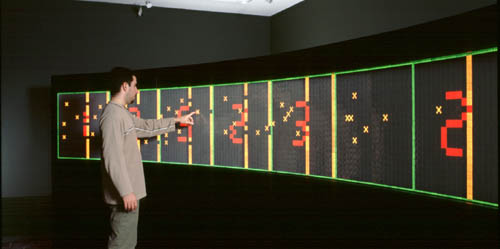







|
|
Overview of the BioWall
In the Logic Systems Laboratory
(LSL) of the Swiss
Federal Institute of Technology in Lausanne (EPFL), we have
been working on bio-inspired hardware for several years. In our
research activities, we have covered most of the possible avenues
for such inspiration, ranging from phylogenetic
systems, inspired by the evolution of biological species, through
ontogenetic
systems, inspired by the development and growth of multicellular
organisms, to epigenetic
systems, inspired by the adaptation of individuals to the environment.
Among all these research axes, the main effort in our lab has been
concentrated on the ontogenetic axis, through the Embryonics
(embryonic electronics) project, which aims at drawing inspiration
from the development of multicellular individuals in order to obtain
in digital hardware some of the features of biological organisms,
and notably growth and fault tolerance.
Our activities have attracted a flattering amount of interest in
the most varied and sometimes unexpected milieus. Among the most
unexpected was undoubtedly Mrs. Jacqueline Reuge, who decided to
fund the construction of a machine to display the principles of
Embryonics to the public within a museum (the Villa
Reuge) built to honor the memory of her late husband. Her generous
support has allowed us to maintain our tradition of always verifying
in hardware the concepts developed for our project.
This serendipitous event allowed us to construct a machine that
would otherwise have remained a dream. We named this machine BioWall
because of its biological inspiration on one side, and because of
its size on the other. In fact, the main goal of the machine being
as a platform to demonstrate the features of our Embryonics systems
to the public through a visual and tactile interaction, the final
implementation of the BioWall weighs in at an impressive 5.3mx0.6mx0.5m=3.68m3
(130 cubic feet).

On this machine we implemented, for the first time in actual hardware,
an organism endowed with all of the features of an Embryonics machine.
The functionality of this organism, the BioWatch, is to count
hours, minutes, and seconds, and is used to demonstrate the growth
and self-repair capabilities of our systems.
In a sense, the implementation of the BioWatch would by itself be
sufficient to justify the effort that has gone into the construction
of our BioWall (the realization of Embryonics systems was, after
all, the goal of the machine). However, in developing our machine,
we quickly realized that the capabilities of such a platform were
not limited to a single application. In fact, as the technical
description of the machine should reveal, it is
an ideal platform to prototype many different kinds of two-dimensional
cellular systems, i.e. systems composed of an array of small, locally-connected
elements.
The applications that correspond to this description are numerous,
and particularly in the domain of bio-inspired systems. For example,
cellular automata (CA) are a very common environment in bio-inspired
research, from the classic Game of Life of John Conway, through self-replicating loops as first developed by Chris
Langton, to Von Neumann's universal constructor
, to name but a few (in growing order of complexity).
And while the BioWall is ideally suited to the implementation of
CAs, it is by no means limited to it. As examples of other possible
bio-inspired systems, we will describe an implementation of a particular
type of artificial neural networks, developed by Alan Turing, and a two-dimensional realization of Firefly,
a machine we designed and built to demonstrate the feasibility of
online hardware evolution.
These applications are just a small sample of the capabilities
of the BioWall, capabilities that we are still discovering. The
cellular structure of the machine make it an ideal platform for
the prototyping of bio-inspired systems, which often exploit this
kind of structure, very common in nature at all levels. Its size
and structure impose a certain number of limitations (e.g., clock
speed), but its complete programmability provides an outstanding
versatility (the different applications we mentioned should be a
sufficient, if incomplete, example) and the visual and interactive
component of the system are invaluable tools both for the dissemination
of ideas and for the verification of research concepts that are
often limited to software simulations.
To conclude, we would like to invite all of you to come and "play"
with the machine at one of the events
in which it will be in public display or by contacting any member
of the staff to arrange a visit
to our laboratory. And, on a more "serious" note, we would
be extremely interested in putting our machine at the disposal of
other research groups, who could be interested in a hardware realization
of their ideas and concepts.
Resources
 |
Prof. D. Mange, head of the project.
© Eurelios
41KB JPEG
|
|
 |
Graphical logo for the BioWall.
© E. Delessert
72KB JPEG |
|
|
|
|






